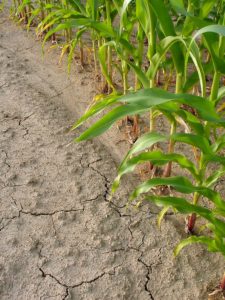 Vegetables are sensitive to hot temperatures–just as they are sensitive to cold temperatures.
Vegetables are sensitive to hot temperatures–just as they are sensitive to cold temperatures.
Each vegetable crop grows best in its own range of temperatures. The optimal temperature range for peppers and eggplants, for example, is 70° to 85°F; pollination will not occur if the night temperature falls below 55°F, and blossoms may fall if the temperature rises above 85°F.
Bean blossoms may drop off if temperatures remain warmer than 85°F for more than a day or two. Tomato flowers may drop if the temperature rises above 90°F during the day or 75°F at night.
When temperatures rise above a plant’s temperature range the plant will go dormant–that is quit growing (the same is true when temperatures fall below the range). If temperatures go too high, plant’s can suffer sunburn and sunscald and plant cells can experience chemical alterations, membrane damage, dehydration, and death. Most plant cells are killed at temperatures from 122°F to 140°F.
Adequate water and shade can help reduce blossom drop and cell damage when temperatures are very warm or hot. Feeding and fertilizing should be decreased or stopped during very warm and hot weather.
Expect loss of blossoms or crops when temperatures deviate from a crop’s temperature range.
Optimal vegetable-growing temperature ranges, with the high end of the range given first:
• 95°F to 65°F (optimal 85°F to 70°F): eggplant, hot peppers, okra, sweet potato, watermelon.
• 95°F to 50°F (optimal 75°F to 60°F): corn, cowpea, New Zealand spinach.
• 90°F to 60°F (optimal 75°F to 65°F): cucumber, muskmelon.
• 90°F to 50°F (optimal 75°F to 65°F): chayote, pumpkin, squash.
• 85°F to 65°F (optimal 75°F to 70°F): sweet pepper, tomato.
• 85°F to 45°F (optimal 75°F to 55°F): chicory, chives, garlic, leek, onion, salsify, shallot.
• 80°F to 50°F (optimal 70°F to 60°F): bean, lima bean.
• 75°F to 45°F (optimal 65°F to 60°F): artichoke, carrot, cauliflower, celeriac, celery, Chinese cabbage, endive, Florence fennel, lettuce, mustard, parsley, pea, potato.
• 75°F to 40°F (optimal 65°F to 60°F): beet, broad bean, broccoli, Brussels sprouts, cabbage, chard, collard, horseradish, kale, kohlrabi, parsnip, radish, rutabaga, sorrel, spinach, turnip.















